
Ducati is one of the world’s most renowned motorcycle manufacturers. It is known for its Italian heritage, innovative engineering, and a legacy on both road and racetrack. Its story is one of technical evolution and resilience, marked by captivating milestones. Founded in 1926 and part of the Volkswagen Group, Ducati produces various motorcycle models, be it for touring, off-road cruising, or sports.
The motorcycles of the company are seen in prestigious racing championships, including MotoGP and World Superbike. The Ducati logo has evolved through the years, and each iteration reflects the durability, passion, and reliability of the motorcycles produced by the company. The article delves into the varied logos that were brought out by Ducati, among other details of the company.
The Genesis of the Ducati Logo (1926 – 1935)
Ducati began as a radio technology company. The very first logo in monochrome featured the word “RADIO” in bold capital letters, which was highlighted by a lightning bolt threading through the “D” to represent innovation and energy. Besides, the logo elements constituted a circle with a thick black outline containing two crossed wires on two sides of the lightning bolt. Beneath it, “BREVETTI DVCATI,” where the letter “U” was replaced by “V,” appeared as a reference to patents and the company founders.
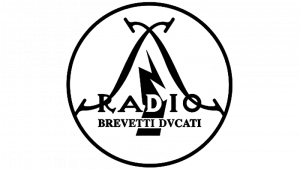
(1935 – 1949)
The 1935 logo variant showed the word “DUCATI” in black uppercase enclosed in a horizontal rectangle with a white background. It was set against the cursive initials “SSR,” where “SSR” stood for Societa Scientifica Radio. Also, every logo element was present inside a roundel with a black outline.
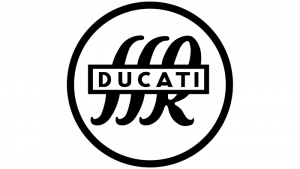
(1949 – 1967)
In 1949, Ducati shifted to motorcycle production, and the logo needed to stand out on fuel tanks. So, the logo featured the word “DUCATI” in white capital letters and rendered using a modern sans-serif typeface. Each letter of the logo had the outlines of black and grey lines.

(1958 – 1959)
To celebrate its racing spirit, Ducati introduced a logo with a laurel wreath encircling a bold “D” in red and white stripes, two stylised wings in golden colour, and the inscription “Ducati Meccanica Bologna” in uppercase and in three levels. The wreath comprised a bright green and a red circle.

(1959 – 1967)
In 1959, the logo variant introduced an eagle, which is a powerful Italian symbol of freedom and dynamism. The eagle gripped a double-pointed flag emblazoned with “MOTO DUCATI” in red.
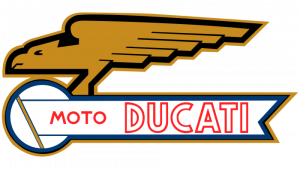
(1967 – 1977)
The 1967 variant became more minimalist, that is, a sleek black wing with white accents having the name “Ducati” in white italics. The emblem resonated with the iconic Scrambler bikes and was affixed as a metal plate rather than a decal. A version with a red outline around “Ducati” debuted on racing motorcycles and soon spread across the lineup.

(1977 – 1985)
Designed by Giorgetto Giugiaro, the 1977 logo featured a geometric, all-caps “DUCATI” made with parallel double lines in black and white. This modernist logotype remained until 1985.

(1985 – 1997)
Cagiva, Ducati’s new owner, introduced a new identity. The logo now included a small elephant (Cagiva’s mascot) in grey and black above the Ducati wordmark by using Cagiva’s serif font. The wordmark was rendered in italicised bold serifs in grey and black.
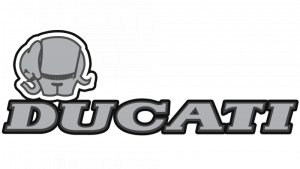
(1997 – 2009)
With new ownership under TPG, Ducati dropped the elephant and developed a streamlined italic logo. Designed by Massimo Vignelli, it featured a bold red wordmark rendered in a Universe italic typeface with an emblem at the end. The emblem depicted a red circle with a white vertical line.

(2009 – Present)
In collaboration with the Landor agency, Ducati revealed its now-trademark red triangular shield, with a curve across it to symbolise speed and racing lines. The Ducati name appears boldly in white uppercase. This logo underscores passion (the red, Italy’s racing colour), performance, and the brand’s global status. The “Ducati Red” is instantly recognisable, and the curving stripe within the shield embodies both racetrack curves and the emotion of riding a Ducati.

An alternate version of the above logo also exists in which the colours are reversed.
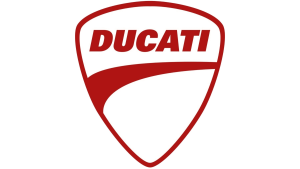
The Elements of the Ducati Logo
Font
The wordmark used in the Ducati logo uses a Universe Black Italic typeface. Created by Adrian Frutiger, the typeface is a strong and confident one.
Colour
The Ducati logo employs red and white colours, where red symbolises passion associated with high-speed motorsport. The colour red also represents victory, thereby affirming the quality of the motorcycles. The white-coloured lettering acts as a visual contrast for better legibility.
The History of Ducati
Ducati was founded on July 4, 1926, in Bologna, Italy, by Adriano, Bruno, and Marcello Ducati. The company began as Società Scientifica Radiobrevetti Ducati, which specialised in the manufacture of radio components such as capacitors, vacuum tubes, and condensers. Its technical prowess saw rapid growth through the 1930s, including the construction of a large factory complex in Borgo Panigale, which still functions as the headquarters of Ducati.
However, during the Second World War, Ducati was the target of sustained heavy bombing. And in spite of the same, the company ensured production and expanded its range to include cameras and electric shavers. After the war, Ducati faced challenges rebuilding and eventually shifted focus. It explored new postwar opportunities with mobility products.
In 1946, Ducati produced its first motorised two-wheeler, the “Cucciolo” (Italian for “puppy”), which was a small auxiliary engine to mount on bicycles. Its popularity saw over 200,000 units sold and prompted Ducati to build complete motorcycles. The first official Ducati motorcycle, based on the Cucciolo engine, debuted in 1949 and was notable for its efficiency and reliability.
By 1950, Ducati’s expansion was in full swing. The product range grew to include the 55M, 65TL, and 65TS. In 1952, Ducati introduced a four-stroke motor scooter, though it was not a commercial success. The company quickly adapted, and by 1954 it was producing 120 bikes a day at its Borgo Panigale plant.
A major landmark came in 1956 with the arrival of designer Fabio Taglioni and the introduction of the legendary desmodromic valve system. It had a unique feature that eliminated valve springs and enabled higher engine speeds and better performance. The “Desmo” system, first seen on the 125 Desmo, remains a cornerstone of Ducati engineering and racing dominance.
Throughout the 1960s and 1970s, Ducati established a reputation for producing high-performance road bikes, like the Mach 1, which was the fastest 250cc road bike of its time. The other superbikes included the celebrated 750 GT and 900 SuperSport. Also, Ducati won many victories in motorsports, such as wins at the Imola 200 and Isle of Man TT.
The 1980s and 1990s saw technological advancements and bold design. Ducati pioneered liquid-cooled superbikes like the Ducati 851 and the 916, which set new standards in performance and aesthetics. The Monster, which was introduced in 1993, became an instant classic and ensured Ducati’s commercial success.
The brand’s racing legacy continued in the World Superbike and MotoGP championships, where it collected numerous titles and podium finishes. The legendary Desmosedici GP machine, introduced in MotoGP, culminated in a World Championship victory with Casey Stoner in 2007 and further titles in the 2020s.
Ducati has changed ownership several times and is currently part of the Volkswagen Group under Audi’s umbrella. However, it still operates as an autonomous entity. Despite these changes, it has maintained its core spirit, that is, Italian design, mechanical excellence, and a relentless pursuit of speed.
Ducati’s global presence is stronger than ever, as it sold over 58,000 motorcycles worldwide in 2023. Its product lineup spans sport, naked, touring, and off-road models. The signature features of its vehicles, such as the V-twin (L-twin) engine layout, Desmo valves, and signature red styling, have become symbols of passionate performance and Italian craftsmanship.
Ducati’s journey began with radios and was forged through war, ingenuity, and a persistent quest for perfection. Today, it stands as a leader in the motorcycle world, cherished for its design, technology, and victorious racing history.
Interesting Facts About Ducati
- Ducati Corse is the racing division responsible for Ducati’s participation in MotoGP and the World Superbike Championship. Ducati has won multiple World Superbike titles and became MotoGP World Champion in 2007 and 2022.
- Ducati was founded in 1926 in Bologna, Italy, as a radio and electronics company called Società Scientifica Radio Brevetti Ducati. Motorcycles came much later in the post-war era.
- The first motorised vehicle brought out by Ducati was the “Cucciolo” (Italian for “puppy”) in 1946. It was a small engine mounted on a bicycle frame, which became a hit in post-war Italy due to its economy.
- Ducati is famous for using a desmodromic valve system. It is a unique engineering solution where valves are opened and closed mechanically, not by springs. This allows higher engine RPMs and precision.
- The Panigale V4 R is one of the fastest and most powerful Ducati bikes. It produces over 240 hp with a racing exhaust system and revs up to 16,500 RPM.
- Ducati is part of the Volkswagen Group through Audi AG. This alliance strengthens Ducati’s engineering and global presence.
- Ducati’s lineup includes legendary models such as the Monster, Multistrada, Diavel, Hypermotard, and Scrambler. Each of these models has a distinct style and performance.
- Ducati motorcycles are known for their striking Italian design, which blends performance with aesthetics. The company often refers to its bikes as “two-wheeled Ferraris.”
- Ducati integrates advanced technologies like cornering ABS, wheelie control, launch control, electronic suspension, and TFT displays into its modern bikes.
- Ducati has a massive and loyal global fanbase. It is supported by Ducati Owners Clubs (DOC) worldwide and annual events like World Ducati Week, which draws thousands of enthusiasts.
Finally
The Ducati logo has evolved over the years, and each logo iteration reflects the brand’s journey. Each logo iteration, which included emblems such as radio bolts, laurels, wings, eagles, elephants, dynamic italics, and the iconic shield, shows its ambitions and market focus at each era. Today, the proud Ducati logo combines its historic passion for speed with a modern global identity.